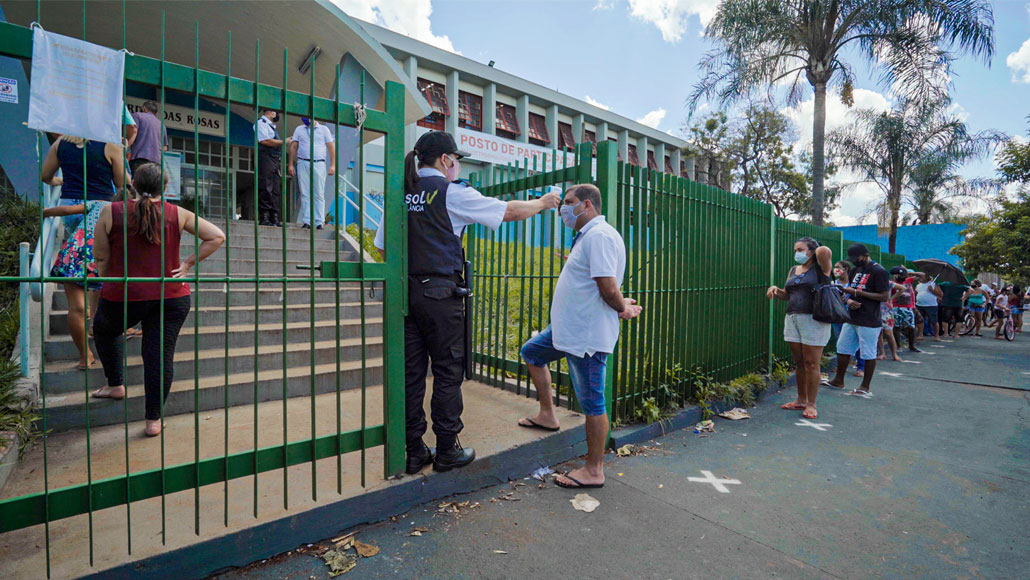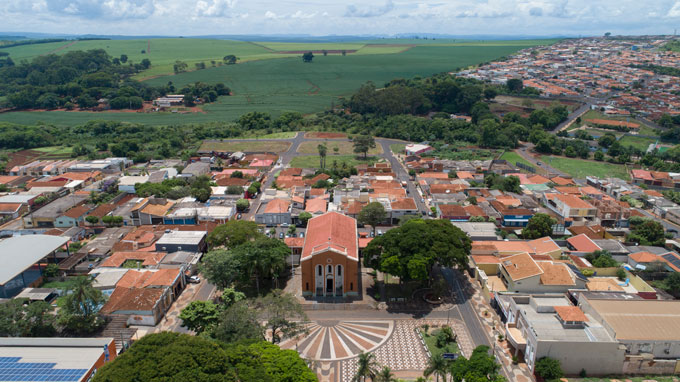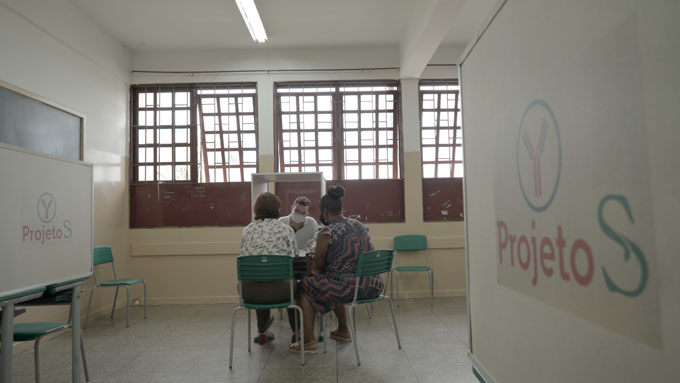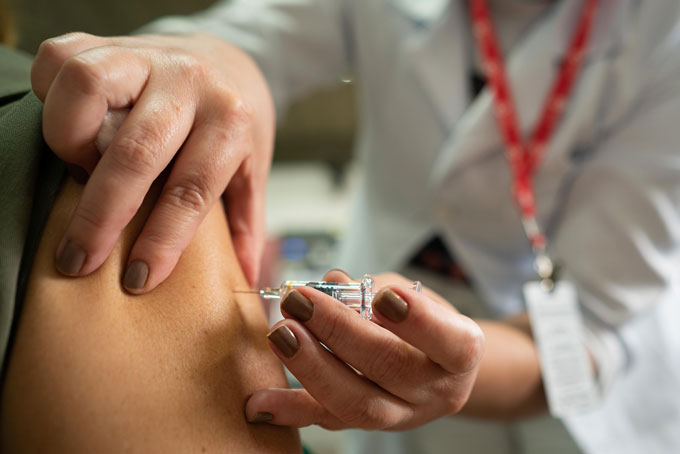How a small city in Brazil may reveal how fast vaccines can curb COVID-19
The aim is to follow the population of Serrana to measure large-scale effects of immunization

Volunteers wait to get a CoronaVac shot in front of State School Jardim das Rosas, one of the vaccination sites for Projeto S.
Divulgação/Instituto Butantan
- More than 2 years ago
The city of Serrana in Brazil is a living experiment.
The picturesque place, surrounded by sugarcane fields, is nestled in the southeast of one of the countries hit hardest by COVID-19. By the end of March, daily deaths in Brazil surged to 3,000 on average a day, a high in a pandemic that has claimed more than 405,000 lives there — the second worst death toll of any country in the world behind only the United States. And as vaccines slowly trickle into the country, only about 15 percent of the population has gotten at least one shot.
Except in Serrana. There, nearly all the adults have gotten their shots. What happens next in this city could provide a glimpse of what the future of the pandemic could be — not only in Brazil but across the globe as vaccinations pick up.
The mass vaccination is an experiment dubbed Projeto S, which will measure the real-world effectiveness of the Chinese-made CoronaVac vaccine, including how well it protects against coronavirus variants. One variant called P.1, which first emerged in the Brazilian Amazon and is now widespread throughout Brazil, shows signs of being both more contagious and able to evade antibodies trained to recognize the coronavirus (SN: 4/14/21).
Among the questions the study may help answer is “whether vaccinated people protect the unvaccinated, how long does their immunity last, and what variants are circulating,” says Marcos Borges, project coordinator and director of the Serrana State Hospital. “We’ll finally be able to observe how a large set of people respond to the vaccine in real-world conditions.”
Projeto S may be the best way to understand the effectiveness of vaccination against COVID-19 in the short and medium terms, says Ethel Maciel, an epidemiologist at the Federal University of Espírito Santo. “This is especially important because we don’t know when we will have most Brazilians vaccinated,” says Maciel, who is not involved in the initiative.

Setting up the project
Serrana has the perfect ingredients for the Projeto S experiment. It’s relatively small, with 45,600 residents, with roughly 30,000 adults. It’s located near an important public health research center, University of São Paulo’s campus in nearby Ribeirão Preto. And the virus was clearly circulating in the community. A July 2020 study “showed that 5 percent of the population carried the active virus — that is one person in 20, a very high rate,” Borges says.
The town’s residents were eager to be vaccinated, however. When the project launched in February, the team at Instituto Butantan, a research facility and vaccine maker based in São Paulo state that is sponsoring the project, set a goal of vaccinating at least 80 percent of town residents over 18 years old. “We took into account that Brazil has a long tradition of good adhesion to vaccination, so we knew these 80 percent were within reach,” says Borges.
By April 11, 27,722 adult volunteers had gotten the first shot and almost all of them, 27,160, had gotten the second jab by the end of that month, meaning 95.7 percent of Serrana’s adults were fully vaccinated. This success came even as Brazilian president Jair Bolsonaro publicly shunned vaccines — CoronaVac in particular — on several occasions.
The vaccine was developed by China-based Sinovac Biotech. It uses an inactivated, or “killed” version of SARS-CoV-2, the virus that causes COVID-19, that can’t cause illness, but can train the body’s immune system to recognize the coronavirus so it can fight back against an encounter with the real pathogen.
In a Phase III clinical trial with 12,600 health care workers in São Paulo, CoronaVac had an efficacy of roughly 50 percent two weeks after the second dose, researchers report in a preliminary study posted April 15 at medRxiv.org. Fifty percent efficacy is the threshold the U.S. Food and Drug Administration set as a baseline for considering emergency use authorization of COVID-19 vaccines in the United States. In comparison, in clinical trials, the Moderna and Pfizer mRNA vaccines had an efficacy of around 95 percent (SN: 11/16/20; SN: 11/18/20).

Like Pfizer’s and Moderna’s vaccines, CoronaVac offers good protection against death and serious forms of COVID-19; of nine health care workers hospitalized with COVID-19, six were unvaccinated, one had had a single dose of CoronaVac and two had gotten both doses. One person —an unvaccinated health care worker — died.
Real-world data
A clinical trial is one thing. The real world is another. For instance, having immunized neighbors might make an important difference in how effective a vaccine actually is. “What is the difference between a vaccine that has 95 percent of individual efficacy and one that has over 50 percent? You’ve got to vaccinate 80 or 85 percent of people with the former to have the disease under control and must vaccinate everyone with the latter to have the same result,” says Ernesto Marques, a virologist at the University of Pittsburgh.
As most adults have been vaccinated in Serrana, Marques says he believes the results will show collective protection — or effectiveness — with CoronaVac, even if individual protection seems low comparatively. This is important not only to Brazil, “but to all countries adopting the vaccine, like Indonesia and Turkey. The results in Serrana will weigh immensely in COVID-19 vaccination policies wherever CoronaVac is used,” he says. Communities in other countries are attempting something similar with other vaccines.
Outcomes may show whether the impact of Serrana’s mass vaccination spills beyond city limits. “Around 15,000 of Serrana’s 45,000 inhabitants commute large distances to work, so we’ll see how it all unfolds with a highly mobile population,” Borges says.
Projeto S is yielding some tantalizing early results. Local media reported that the number of daily COVID-related infections decreased from 28 on March 20 to seven a month later. The share of cases that were severe dropped from a peak of 70 percent this March to 10 percent in early April.

During the project’s vaccination from mid-February to mid-April, six immunized people died from COVID-19, according to the state government of São Paulo. Of those, five had received only one dose and the other person showed symptoms shortly after receiving the second dose, which leads researchers to believe the patient was already infected at the time of the second shot. Among the unvaccinated there were 14 deaths.
In the beginning of May, none of the six infirmary beds at Serrana’s Santa Casa Hospital and the city’s Basic Healthcare Unit are occupied, and the waiting line for beds both in infirmaries and intensive care units has zeroed. As of May 3, there is one Serrana resident in an infirmary and nine patients in an ICU, according to the Serrana Health Secretariat.
Nurse Glenda de Moraes, who has worked for two decades in Serrana and is involved in the coordination of Projeto S, says that positive test results have dropped, too, “to less than 20 percent [per day], way less than the 30 to 40 percent of positives we had before.”
Still according to the local Health Secretariat, confirmed cases peaked in January 2021, with 706 city residents infected with COVID-19. Infections then decreased in February and March (484 and 692 cases, respectively) and had a sharp drop in April, with 235 confirmed cases.
All of this is clearly “an effect from the vaccination,” Maciel says. But Borges is more cautious in relating all these changes to the mass immunization. “We are still studying it and when we have the results, we’ll be able to affirm for sure if these events are related,” he says.
Projeto S will continue following residents for a year. The questions that tracking can answer — for instance, how long does a vaccine provide protection — are crucial to helping Brazilians, and the rest of the world, find the path out of the pandemic.
Juliana Elaga, the first person to be vaccinated in Serrana, is sure this is the way out. “I suffered a lot with the pandemic, and the vaccination was a really emotional moment for me. I felt truly relieved after the second jab. Even still adopting social distancing and mask-wearing, my heart is more at rest.” Her 8-year-old, Petras, is a witness: “Mom used to wear two masks at once and rub her hands with alcohol-gel all the time. Now she seems a little more normal and not so worried all the time.”
Sign up for our newsletter
We summarize the week's scientific breakthroughs every Thursday.







